Sir John Monash, Personal Files Book 15, 1 April - 10 May 1917, Part 3

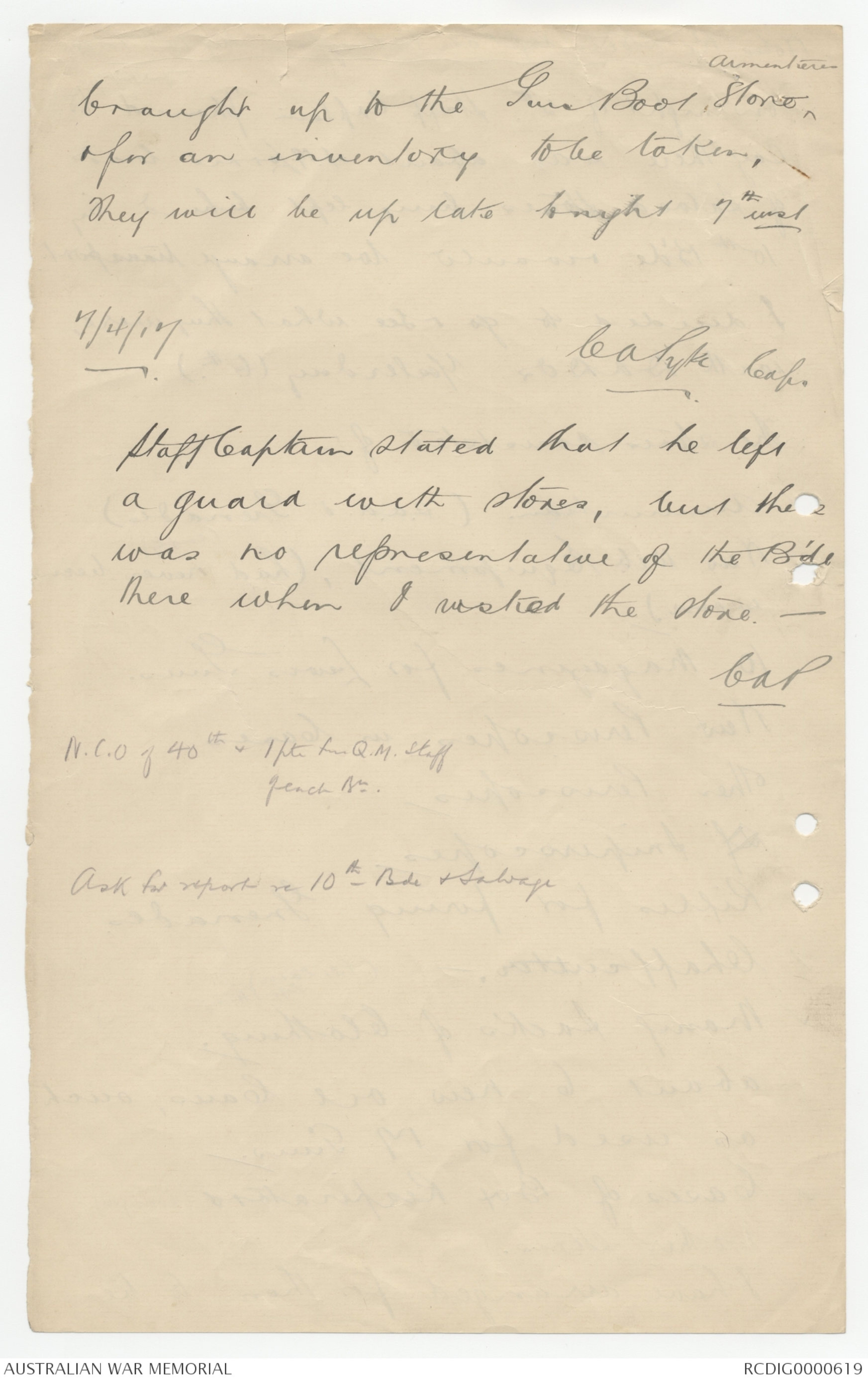
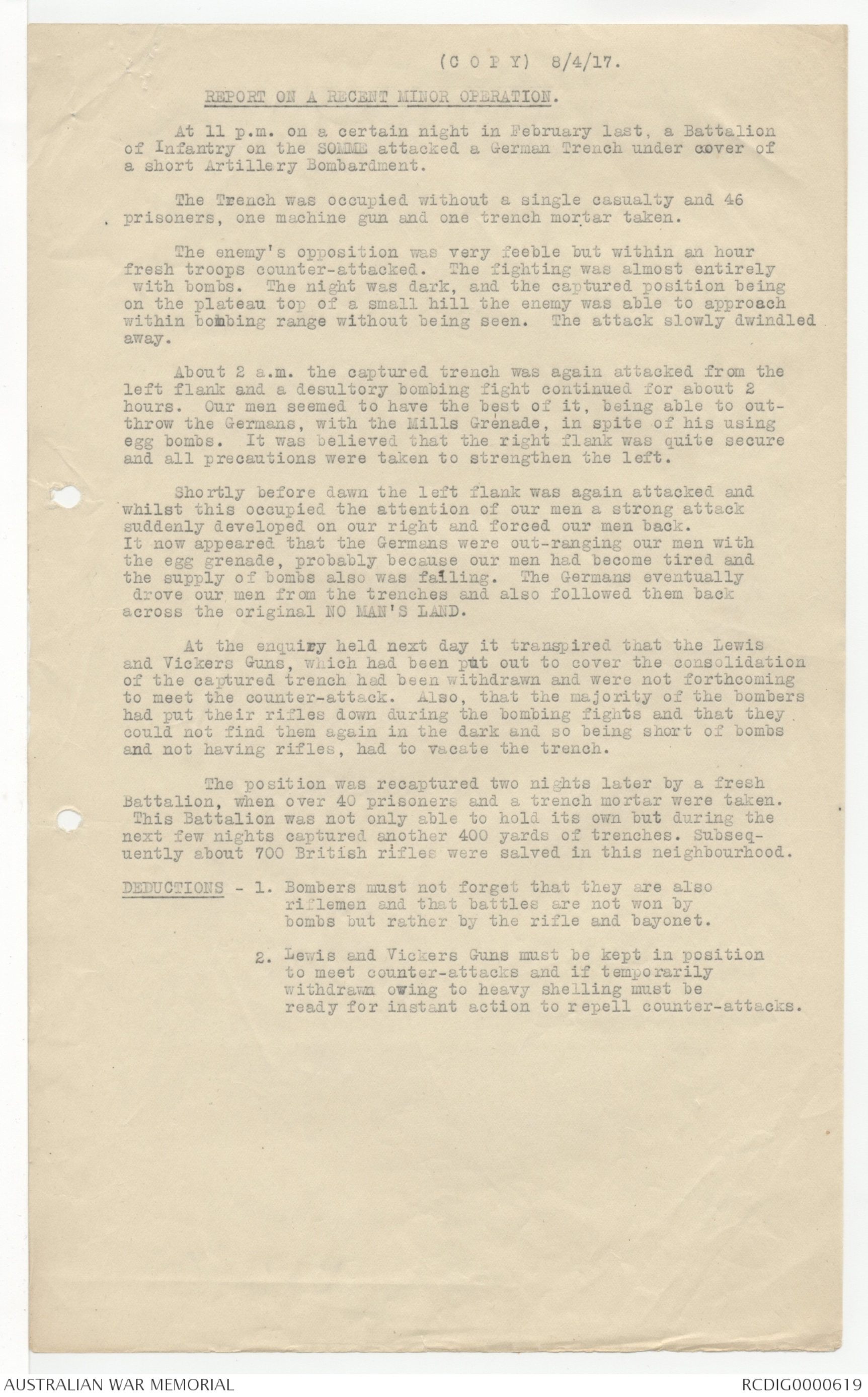
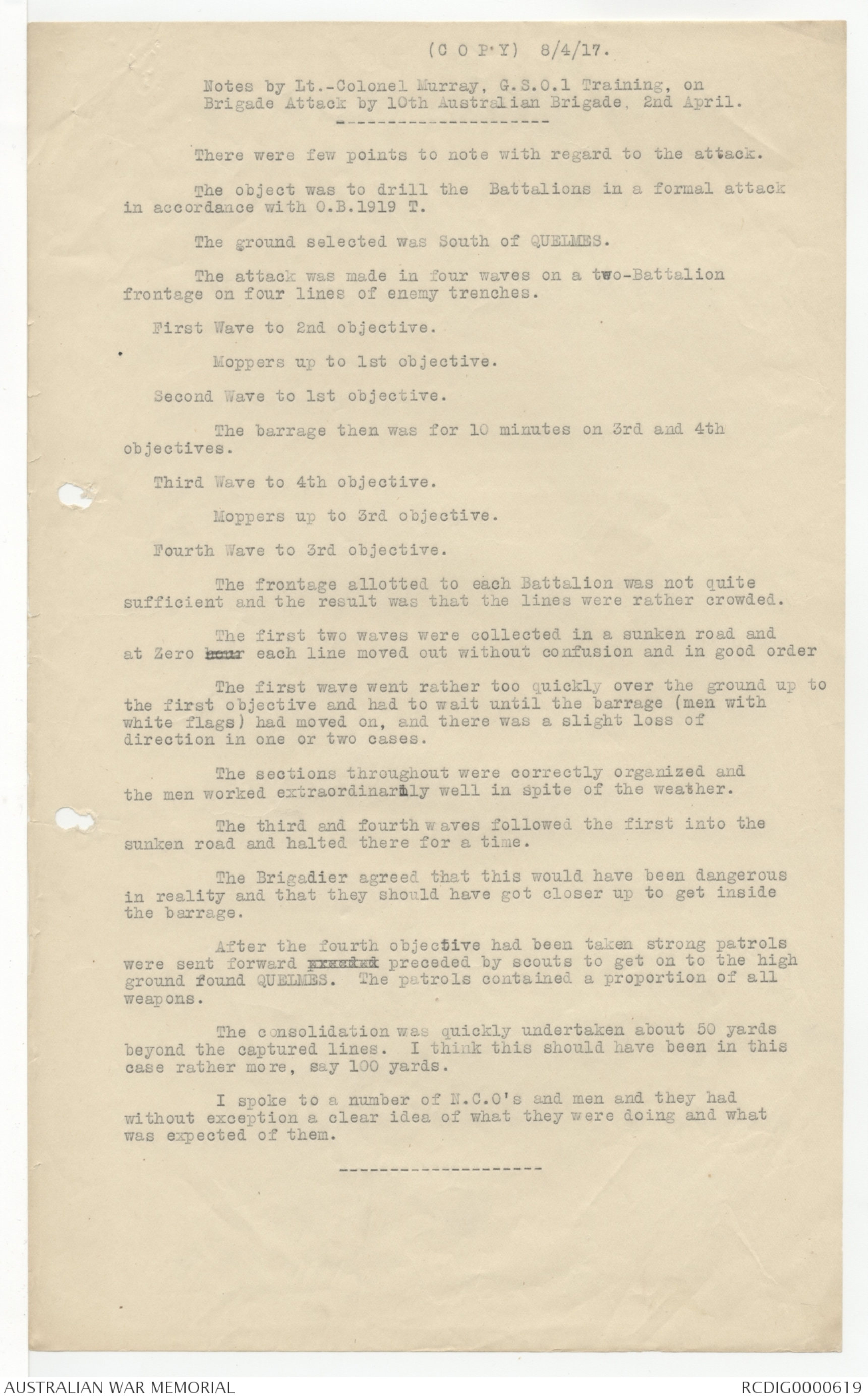
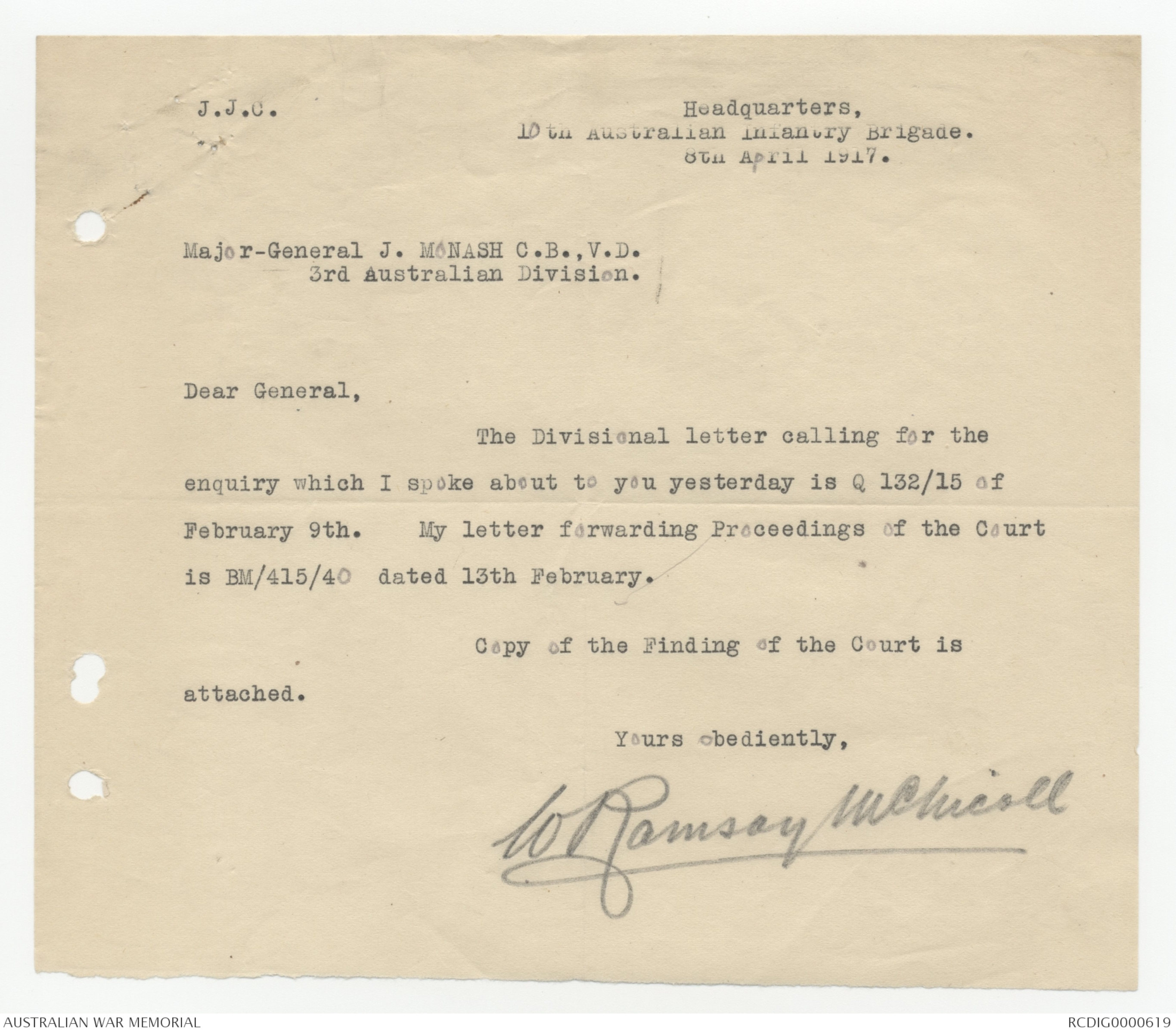
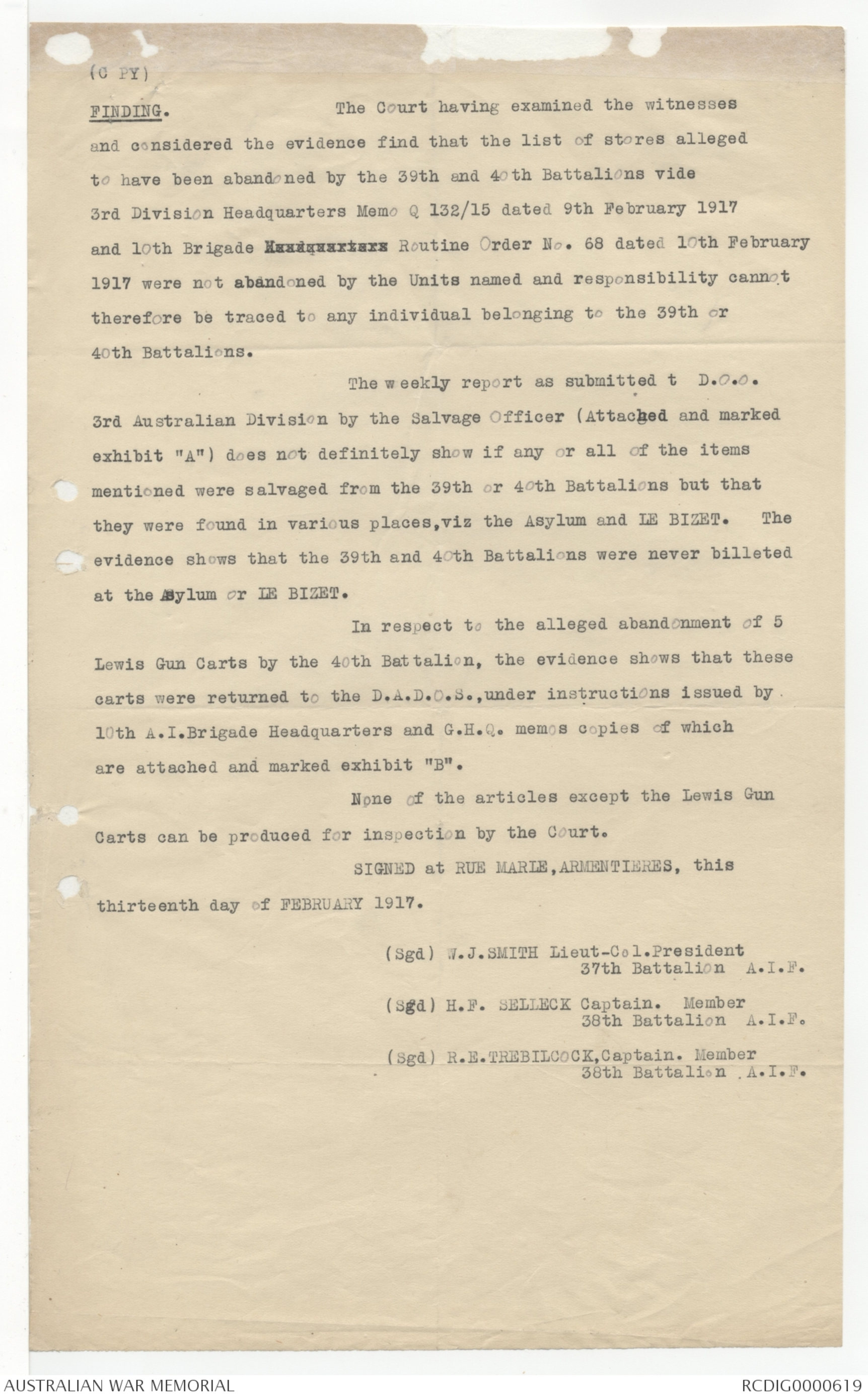
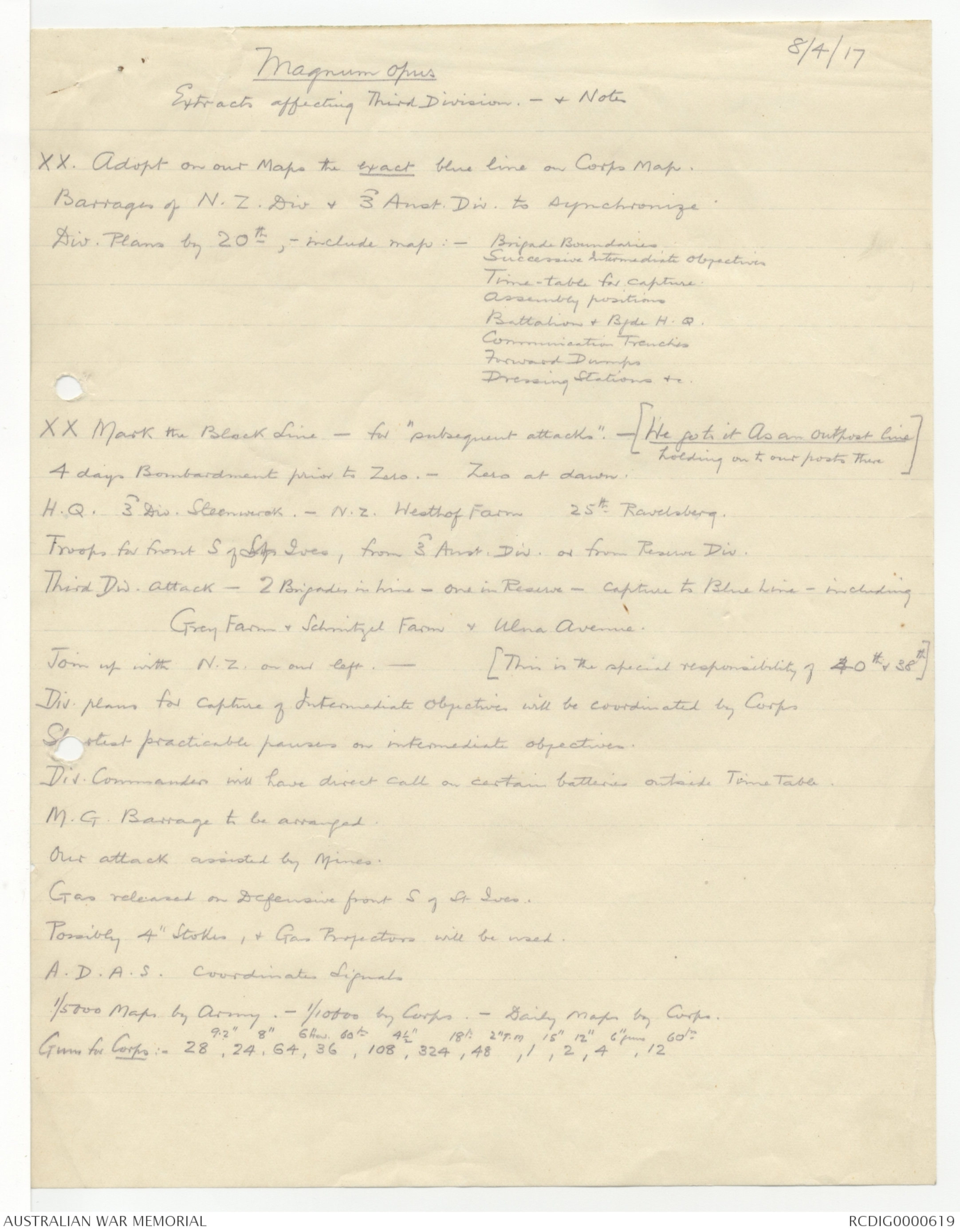
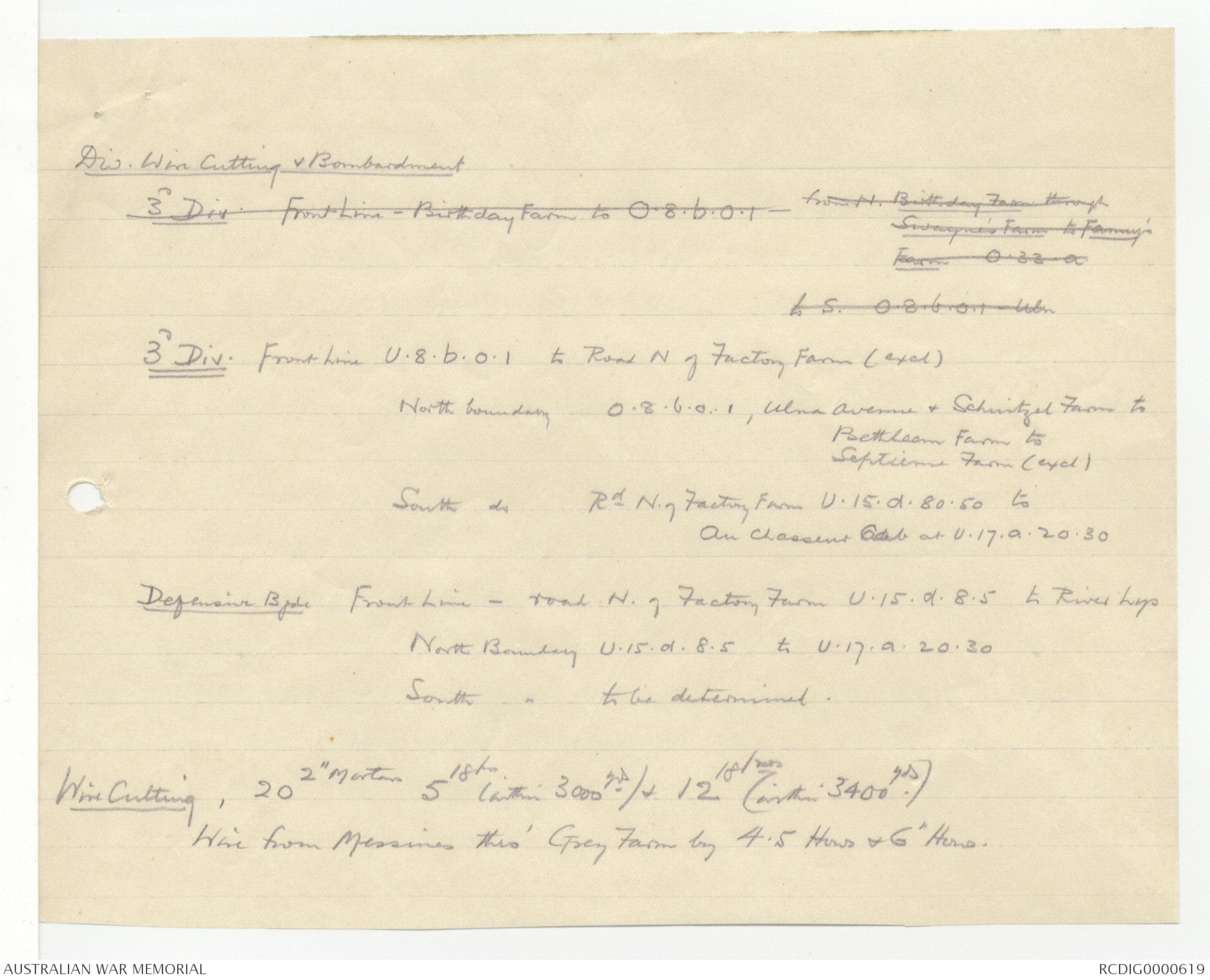
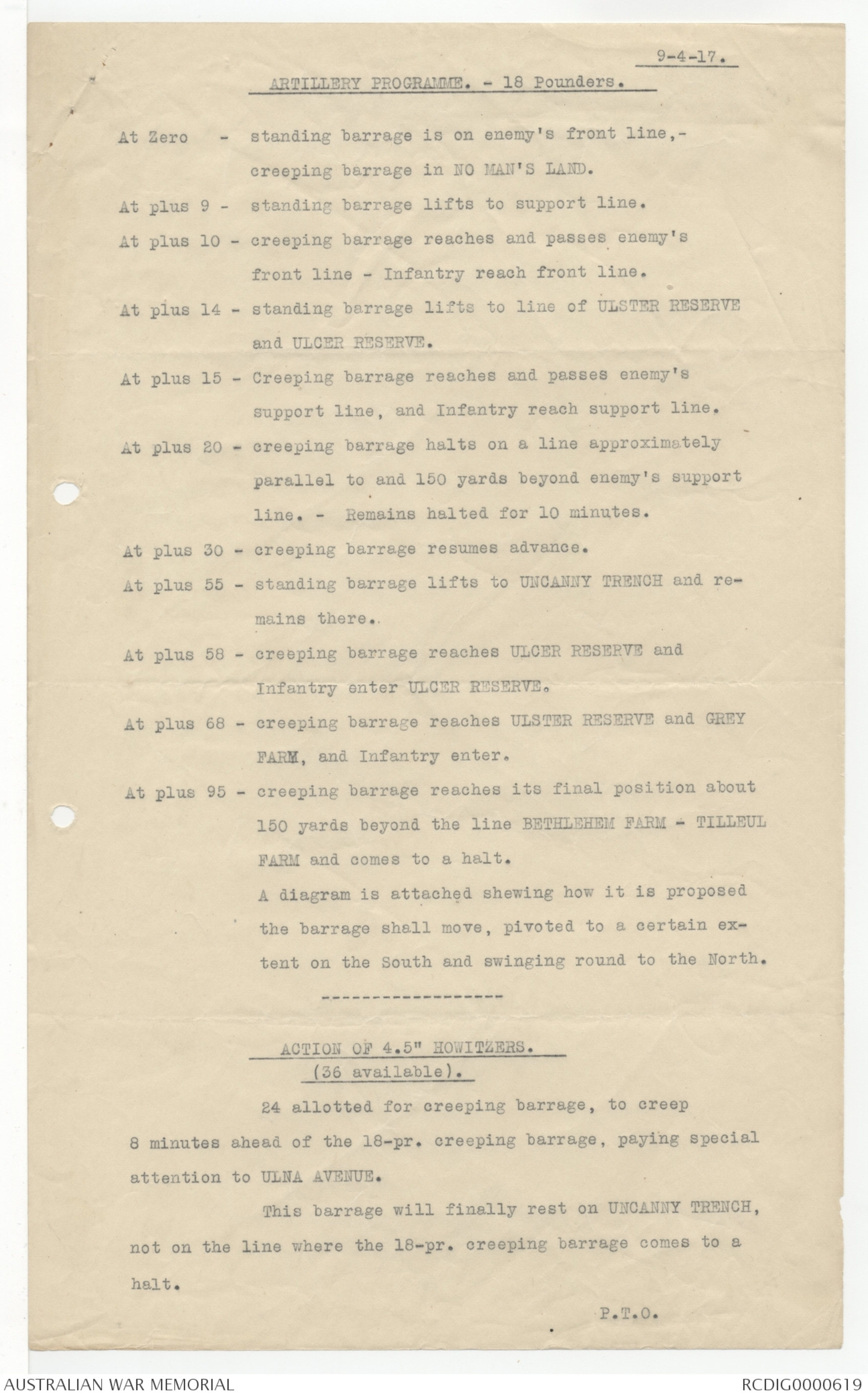
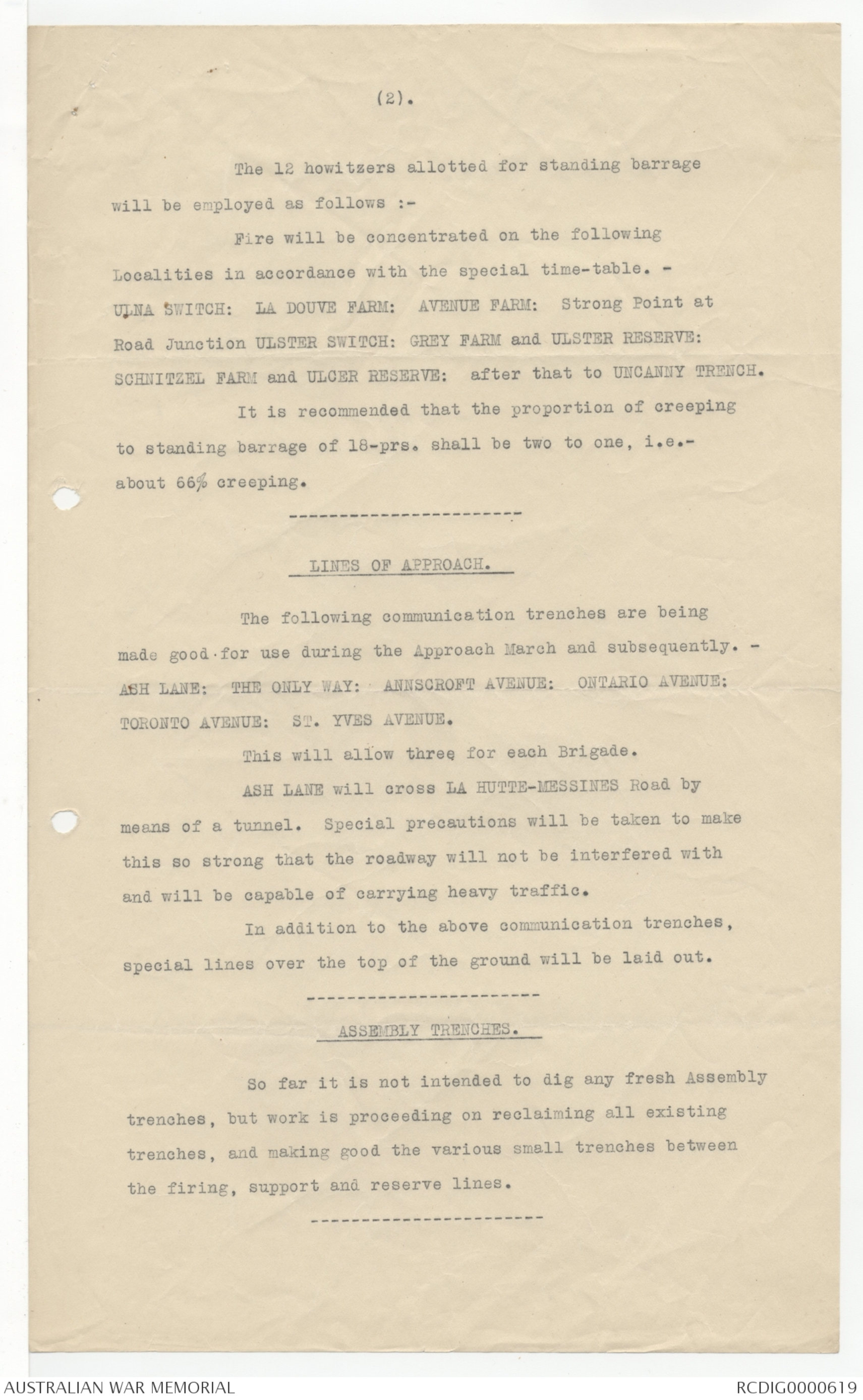
Notes Re Stores left at Tatinghen by 10th Bde
7-4-17
On night of 5th Staff Captain 'phoned to
say there was about 4.M. Lorrie loads
of Salved stores being left behind by
10th B'de & would we arrange transport.
I decided to go & see what they were,
with DADOs Yesterday (6th.)
The stores consisted of:-
Ammunition, (S.A.A. & Grenades)
(empty)
New Web Equipment, (had never been
worn.)
10 Magazines for Lewis Guns.
New Periscopes in cases
other Periscopes.
Sf Sniperscopes
Rifles for firing Grenades.
Chaffcutter. - (told Dados staff) (Harrington or Downes)
Many sacks of Clothing.
about 6 new oil cans, such
as used for M.Guns.
Cases of Box Respirators (damaged)
& other stores.
I have arranged for them to be
brought up to the Gum Boot Store ^Armentieres
& for an inventory to be taken,
They will be up late tonight 7thinst
7/4/17 CA Pyke Cap.
Staff Captain stated that he left
a guard with stores, but there
was no representative of the B'de
there when I visited the store.-
CAP
N.C.O. of 40th & 1 pte from Q.M. Staff
French Bn
Ask for report re 10th Bde & Salvage
( COPY ) 8/4/17.
REPORT ON A RECENT MINOR OPERATION.
At 11 p.m. on a certain night in February last, a Battalion
of Infantry on the SOMME attacked a German Trench under cover of
a short Artillery Bombardment.
The Trench was occupied without a single casualty and 46
prisoners, one machine gun and one trench mortar taken.
The enemy's opposition was very feeble but within an hour
fresh troops counter-attacked. The fighting was almost entirely
with bombs. The night was dark, and the captured position being
on the plateau top of a small hill the enemy was able to approach
within bombing range without being seen. The attack slowly dwindled
away.
About 2 a.m. the captured trench was again attacked from the
left flank and a desultory bombing fight continued for about 2
hours. Our men seemed to have the best of it, being able to outthrow
the Germans, with the Mills Grenade, in spite of his using
egg bombs. It was believed that the right flank was quite secure
and all precautions were taken to strengthen the left.
Shortly before dawn the left flank was again attacked and
whilst this occupied the attention of our men a strong attack
suddenly developed on our right and forced our men back.
It now appeared that the Germans were out-ranging our men with
the egg grenade, probably because our men had become tired and
the supply of bombs also was failing. The Germans eventually
drove our men from the trenches and also followed them back
across the original NO MAN'S LAND.
At the enquiry held next day it transpired that the Lewis
and Vickers Guns, which had been put out to cover the consolidation
of the captured trench had been withdrawn and were not forthcoming
to meet the counter-attack. Also, that the majority of the bombers
had put their rifles down during the bombing fights and that they
could not find them again in the dark and so being short of bombs
and not having rifles, had to vacate the trench.
The position was recaptured two nights later by a fresh
Battalion, when over 40 prisoners and a trench mortar were taken.
This Battalion was not only able to hold its own but during the
next few nights captured another 400 yards of trenches. Subsequently
about 700 British rifles were salved in this neighbourhood.
DEDUCTIONS - 1. Bombers must not forget that they are also
riflemen and that battles are not won by
bombs but rather by the rifle and bayonet.
2. Lewis and Vickers Guns must be kept in position
to meet counter-attacks and if temporarily
withdrawn owing to heavy shelling must be
ready for instant action to repell counter-attacks.
( COPY) 8/4/17
Notes by Lt. -Colonel Murray, G.S.O.1 Training, on
Brigade Attack by 10th Australian Brigade, 2nd April.
There were few points to note with regard to the attack.
The object was to drill the Battalions in a formal attack
in accordance with O.B.1919 T.
The ground selected was South of QUELMES.
The attack was made in four waves on a two-Battalion
frontage on four lines of enemy trenches.
First Wave to 2nd objective.
Moppers up to 1st objective.
Second Wave to 1st objective.
The barrage then was for 10 minutes on 3rd and 4th
objectives.
Third Wave to 4th objective.
Moppers up to 3rd objective.
Fourth Wave to 3rd objective.
The frontage allotted to each Battalion was not quite
sufficient and the result was that the lines were rather crowded.
The first two waves were collected in a sunken road and
at Zero hour each line moved out without confusion and in good order
The first wave went rather too quickly over the ground up to
the first objective and had to wait until the barrage (men with
white flags) had moved on, and there was a slight loss of
direction in one or two cases.
The sections throughout were correctly organized and
the men work extraordinarily well in spite of the weather.
The third and fourth waves followed the first into the
sunken road and halted there for a time.
The Brigadier agreed that this would have been dangerous
in reality and that they should have got closer up to get inside
the barrage.
After the fourth objective had been taken strong patrols
were sent forward precded preceded by scouts to get on to the high
ground round QUELMES. The patrols contained a proportion of all
weapons.
The consolidation was quickly undertaken about 50 yards
beyond the captured lines. I think this should have been in this
case rather more, say 100 yards.
I spoke to a number of N.C.O's and men and they had
without exception a clear idea of what they were doing and what
was expected of them.
J.J.C.
Headquarters,
10th Australian Infantry Brigade.
8th April 1917.
Major-General J.MONASH C.B., V.D.
3rd Australian Division.
Dear General,
The Divisional letter calling for the
enquiry which I spoke about to you yesterday is Q 132/15 of
February 9th. My letter forward Proceedings of the Court
is BM/415/40 dated 13th February.
Copy of the Finding of the Court is
attached.
Yours obediently,
W Ramsay McNicoll
(COPY)
FINDING. The Court having examined the witnesses
and considered the evidence find that the list of stores alleged
to have been abandoned by the 39th and 40th Battalions vide
3rd Division Headquarters Memo Q 132/15 dated 9th February 1917
and 10th Brigade Headquarters Routine Order No. 68 dated 10th February
1917 were not abandoned by the Units named and responsibility cannot
therefore be traced to any individual belonging to the 39th or
40th Battalions.
The weekly report as submitted t D.O.O.
3rd Australian Division by the Salvage Officer (Attached and marked
exhibit "A") does not definitely show if any or all of the items
mentioned were salvaged from the 39th or 40th Battalions but that
they were found in various places, viz the Asylum and LE BIZET. The
evidence shows that the 39th and 40th Battalions were never billeted
at the Asylum or LE BIZET.
In respect to the alleged abandonment of 5
Lewis Gun Carts by the 40th Battalion, the evidence show that these
carts were returned to the D.A.D.O.S., under instructions issued by
10th A.I.Brigade Headquarters and G.H.Q. memos copies of which
are attached and marked exhibit "B".
None of the articles except the Lewis Gun
Carts can be produced for inspection by the Court.
SIGNED at RUE MARLE, ARMENTIERES, this
thirteenth day of FEBRUARY 1917.
(Sgd) W.J.SMITH Lieut-Col. President
37th Battalion A.I.F.
(Sgd) H.F. SELLECK Captain. Member
38th Battalion A.I.F.
(Sgd) R.E.TREBILCOCK, Captain. Member
38th Battalion A.I.F.
8/4/17
Magnum Opns
Extracts affecting Third Division. - & Notes
XX. Adopt on our Maps the exact blue line on Corps Map.
Barrages of N.Z. Div & 3d Aust.Div. to synchronize.
Div. Plans by 20th, - include map:- Brigade Boundaries
Successive Intermediate Objectives
Time-table for capture.
Assembly positions
Battalion & Bgde H.Q.
Communication Trenches
Forward Dumps
Dressing Stations &c.
XX Mark the Black Line - for "subsequent attacks."-[We go to it as an outpost line holding on to our posts there]
4 days Bombardment prior to Zero. - Zero at dawn.
H.Q. 3d Div. Steenwerck. - N.Z. Westhof Farm 25th Ravelsberg.
Troops for front S of St Ives, from 3d Aust. Div. or from Reserve Div.
Third Div. attack - 2 Brigades in line - one in Reserve - capture to Blue Line - including
Grey Farm & Schnitzel Farm & Ulna Avenue.
Join up with N.Z. on our left. - [This is the special responsibility of 40th & 38th]
Div. plans for capture of Intermediate Objectives will be coordinated by Corps
Shortest practicable pauses on intermediate objectives.
Div. Commander will have direct call on certain batteries outside Time Table.
M.G. Barrage to be arranged.
Our attack assisted by Mines.
Gas release on Defensive front S of St Ives.
Possibly 4" Stokes, & Gas Projectors will be used.
A.D.A.S. Coordinate Signals
1/5000 Maps by Army. - 1/1000 by Corps. - Daily Maps by Corps.
Guns for Corps:- 28 9.2", 24 8", 64 6How., 36 60prs, 108 4½", 324 18prs, 48 2"T.M, 1 15",
2 12", 4 6"guns, 12 60prs
Div. Wire Cutting vs Bombardment
3d Div. Front Line - Birthday Farm to 0.8.6.01 - from N Birthday Farm throughSwayne's Farm to Fanny'sFarm 0.33.00
to S. 0.8.6.01 - Uln
3d Div. Front Line U.8.b.0.1 to Road N of Factory Farm (excl)
North boundary 0.8.6.0.1, Ulna Avenue + Schnitzel Farm to
Bethleem Farm to
Septieme Farm (excl)
South do Rd N. of Factory Farm U.15.d.80.50 to
Au Chasseur [[Cav?]] at U.17.0.20.30
Defensive Bgde Front Line - road N. of Factory Farm U.15.d.8.5 to River Lys
North Boundary U.15.8.5 to U.17.a.20.30
South " to be determined.
Wire Cutting, 20 2 " Mortars 5 18prs (within 3000 yds) & 12 18/pdrs (within 3400 yds)
Wire from Messines thro' Grey Farm by 4.5 Hows + 6" Hows.
9-4-17.
ARTILLERY PROGRAMME. - 18 Pounders.
At Zero - standing barrage is on enemy's front line,-
creeping barrage in NO MAN'S LAND.
At plus 9 - standing barrage lifts to support line.
At plus 10 -creeping barrage reaches and passes enemy’s
front line - Infantry reach front line.
At plus 14 -standing barrage lifts to line of ULSTER RESERVE
and ULCER RESERVE.
At plus 15 - Creeping barrage reaches and passes enemy's
support line, and Infantry reach support line.
At plus 20 - creeping barrage halts on a line approximately
parallel to and 150 yards beyond enemy's support
line. - Remains halted for 10 minutes.
At plus 30 - creeping barrage resumes advance.
At plus 55 - standing barrage lifts to UNCANNY TRENCH and remains
there.
At plus 58 - creeping barrage reaches ULCER RESERVE and
Infantry enter ULCER RESERVE.
At plus 68 - creeping barrage reaches ULSTER RESERVE and GREY
FARM, and Infantry enter.
At plus 95 - creeping barrage reaches its final position about
150 yards beyond the line BETHLEHEM FARM - TILLEUL
FARM and comes to a halt.
A diagram is attached shewing how it is proposed
the barrage shall move, pivoted to a certain extent
on the South and swinging round to the North.
ACTION OF 4.5" HOWITZERS.
(36 available).
24 allotted for creeping barrage, to creep
8 minutes ahead of the 18-pr. creeping barrage, paying special
attention to ULNA AVENUE.
This barrage will finally rest on UNCANNY TRENCH,
not on the line where the 18-pr. barrage comes to a
halt.
P.T.O.
(2).
The 12 howitzers allotted for standing barrage
will be employed as follows:-
Fire will be concentrated on the following
Localities in accordance with the special time-table. -
ULNA SWITCH: LA DOUVE FARM: AVENUE FARM: Strong Point at
Road Junction ULSTER SWITCH: GREY FARM and ULSTER RESERVE:
SCHNITZEL FARM and ULCER RESERVE: after that to UNCANNY TRENCH.
It is recommended that the proportion of creeping
to standing barrage of 18-prs. shall be two to one, i.e.-
about 66% creeping.
LINES OF APPROACH.
The following communication trenches are being
made good for use during the Approach March and subsequently. -
ASH LANE: THE ONLY WAY: ANNSCROFT AVENUE: ONTARIO AVENUE:
TORONTO AVENUE: ST. IVES AVENUE.
This will allow three for each Brigade.
ASH LANE will cross LA HUTTE-MESSINES Road by
means of a tunnel. Special precautions will be taken to make
this so strong that the roadway will not be interfered with
and will be capable of carrying heavy traffic.
In addition to the above communication trenches,
special lines over the top of the ground will be laid out.
ASSEMBLY TRENCHES.
So far it is not intended to dig any fresh Assembly
trenches, but work is proceeding on reclaiming all existing
trenches, and making good the various small trenches between
the firing, support and reserve lines.
 Deb Parkinson
Deb ParkinsonThis transcription item is now locked to you for editing. To release the lock either Save your changes or Cancel.
This lock will be automatically released after 60 minutes of inactivity.